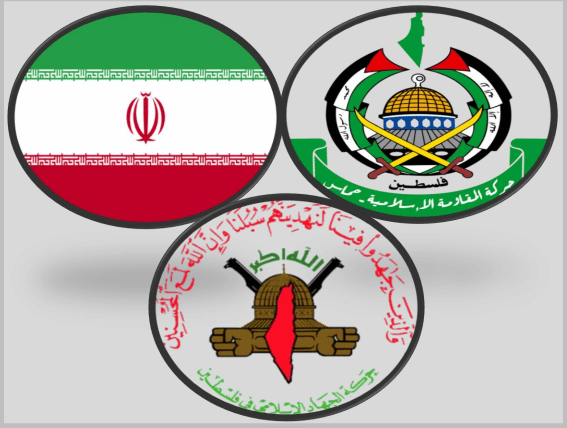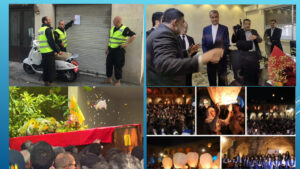Terrorism and clashes in the West Bank rose dramatically in 2022, and Iranian terrorist financing is playing a significant role in throwing additional fuel on the fire.
While much of the terrorism in the sector has been initiated by localized cells and Palestinian individuals unaffiliated with any specific organization, Hamas, which rules the Gaza Strip, and Palestinian Islamic Jihad, the second largest terror faction in Gaza, also remain highly active in the West Bank.
Both of these organizations enjoy a collective annual Iranian funding program totaling 150 million dollars, and both offer money to anyone in the West Bank who is prepared to plan and launch terrorist attacks against Israeli civilians or member of the security forces, even if they are not formally affiliated with any Palestinian organization.
This means that cash for buying firearms, like a standard M-16, which today costs between 80 to 90 thousand shekels in the West Bank, or a Carlo sub-machine gun, made in local Palestinian workshops and costing 2 to 5 thousand shekels, is available for those who will turn their guns on Israelis. The same is true of bomb-making material.
At the same time, Hamas and PIJ are involved in daily efforts to set up organized terror cells in the West Bank, equip them with firearms and bombs, and instruct them on attacks.
Much of the money for all of these efforts comes from Iran, and some also comes from Hamas’s fund-raising networks in Turkey.
Recently, PIJ has even attempted to exploit Israel’s policy of allowing some 17,000 Gazans to work in Israel with permits. The Shin Bet revealed on November 24 that a Gazan with a work permit in Israel had intended to detonate a bomb on-board a bus in southern Israel.
The suspect was named as Fathi Ziad Zakut, 31, of Rafah, and according to the Shin Bet, he was recruited by PIJ, receiving training in handling explosives from a Gazan bomb-making expert.
Zakut began collecting bomb-making components after starting to work in Israel, the Shin Bet said.
As the Palestinian Authority’s grip on northern Palestinian cities like Jenin and Nablus falters, Palestinian Islamic Jihad – the terror faction most closely aligned with Iran and its Khomenist revolutionary ideology – sees an opportunity.
Around 25% of Jenin’s population is affiliated with PIJ (and a further 20% is affiliated with Hamas). The PIJ organization’s senior operatives in Gaza, as well as in Syria – where it maintains a headquarters headed by Ziad Al-Nakleh – are working tirelessly to try and boost its terrorist capabilities in Jenin and in other West Bank sectors.
For PIJ, Jenin is a prime first step towards the goal of expanding its influence and presence significantly in the West Bank, taking advantage of the increase in violence and the Palestinian Authority’s growing weakness.
It is mainly the IDF and the Shin Bet intelligence agency that are keeping these plans in check. This is achieved by the ongoing matching of precise intelligence on PIJ activities with the advanced counter-terrorism capabilities of Israeli elite forces.
This was displayed overnight on December 1, a senior PIJ terrorist, Muhmmad Sa’adi, together with a second combatant affiliated with the Al Aqsa Martyrs Brigade, were killed in a gun battle with special IDF units in the town of Wadi Burqin, 5 kilometers west of Jenin. Soldiers from the undercover IDF Duvdevan unit, the Haruv Reconnaissance unit, and the Shin Bet took part in the raid,
The two were killed during an Israeli operaton to arrest three wanted individuals suspected of involvement in terrorist activities.
The IDF said that Saadi, a high-ranking operative in PIJ, was killed had previously carried out several shooting attacks on Israeli forces, while working to supply PIJ operatives with weapons, and implementing orders from the leadership of organization.
PIJ is the Gaza Strip’s second-largest terror faction, and in August 2022, it spent three days fighting a conflict with Israel, after trying to create a linkage between escalations in the West Bank and the Gaza Strip.
Israel launched Operation Breaking Dawn on August 5 as part of its rejection of this attempt by PIJ to impose an ‘equation’ on it, and as part of Israel’s rejection of PIJ’s effort to restrict Israeli freedom of opportunity in the West Bank by threatening escalations from Gaza.
Notably, Hamas remained on the sidelines during that escalation, possibly in order to demonstrate to Palestinians that its capabilities are superior to those of PIJ, which sustained damaging blows from the IDF and was unable to produce tangible achievements.
While PIJ continues to build rockets and recruit personnel in Gaza, it is seeking to create a new front in the West Bank, and this aligns closely with the grand strategy of the PIJ’s backers, the Iranian Islamic Revolutionary Guards Corps.
IRGC officials have repeatedly and publicly stated their goal of arming the West Bank, and in August, a report by the Fars semi-official Iranian media outlet cited IRGC commander Hossein Salami as stating that Iran’s goal is to create the conditions for a multi-front war against Israel, including Gaza and the West Bank, as well as Lebanon and Syria.
On August 2, three days prior to the start of hostilities in Gaza, Al-Nakhleh was visiting Iran, and heard from his host, IRGC chief Salami, “The liberation of the Palestinian people is more than just a wish for us; it is a basic strategy. If it were just a heartfelt wish, it would not be defined as an actual objective. Ayatollah Ruhollah Khomeini [founder of the Islamic Republic] and Ayatollah Ali Khamenei, the current Supreme Leader, taught us to see it as a goal and a strategy that will lead to liberating holy Quds [Jerusalem] and to restoring the lost, occupied lands of Palestine to their original owners.”
The fact that the Iranian – PIJ axis directly threatens the PA was reflected in the raid that Palestinian security forces launched on November 27 against a PIJ bomb-making lab in Jenin, thwarting, according to reports, a series of intended bombings against Israeli and seizing five large bombs and six pipe bombs, as well as ingredients for making more explosives.
A second security raid by the PA targeted operatives linked to that bomb plot in the West Bank city of Tubas, northeast of Nablus.
The PA’s status in the West Bank is threatened by both Hamas and PIJ’s goals of setting the area on fire from Gaza, undermining its ability to rule, and promoting the message of radial Islamist-fueled conflict as a substitute to the logic of the PA.
The PA was founded on the idea of cooperation and coordination with Israel (even as the PA clashes with Israel on the diplomatic front, and promotes incitement against it on a daily basis to preserve its legitimacy and dodge accusations by its Islamist rivals of being a collaborator of the Jewish state).
The daily battle between Israel’s security agencies and Iranian-fueled efforts by Palestinian terror organizations to add fuel to the fire is set to the continue.






